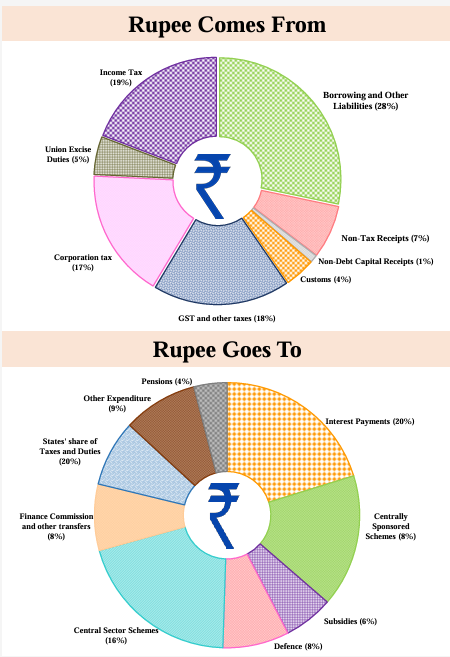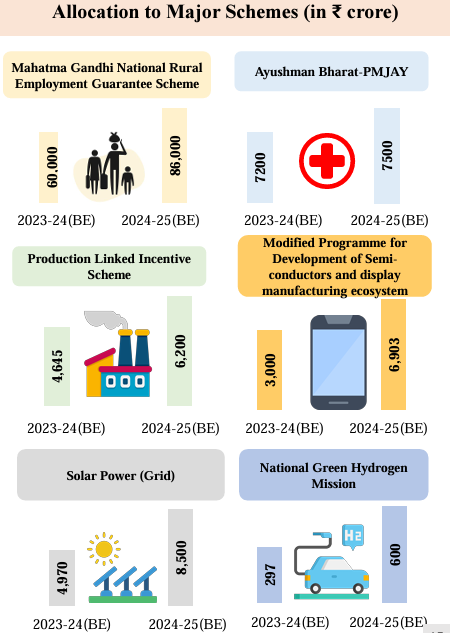Economy
Interim Budget 2024-2025
- 05 Feb 2024
- 16 min read
For Prelims: Capital expenditure, Fiscal deficit, Direct & Indirect taxes, Lakhpati Didis, NaMo Bharat, Nano-DAP, Cervical Cancer Vaccination, Rooftop solarization, PM-SVANidhi, Mudra Yojana, Fasal Bima Yojana, Coal gasification, Ayushman Bharat, Oilseeds, Multidimensional poverty, Order of Distribution of Government Investment Across Various Sectors.
For Mains: Major Development Plans in Interim Budget 2024-2025
Why in News?
Recently, the Interim Budget 2024-25 was tabled in the parliament. It envisions 'Viksit Bharat' by 2047, with all-round, all-pervasive, and all-inclusive development.
What is an Interim Budget?
- An Interim Budget is presented by a government that is going through a transition period or is in its last year in office ahead of general elections.
- The purpose of the interim budget is to ensure the continuity of government expenditure and essential services until the new government can present a full-fledged budget after taking office.
What is the Difference Between Interim Budget and Vote on Account?
| Feature | Interim Budget | Vote on Account |
| Constitutional Provision | Article 112 | Article 116 |
| Purpose | Financial Statement presented by the government ahead of general elections. |
To meet essential government expenditures for a limited period until the budget is approved. |
| Duration of Expenditure | Covers a specific period, usually a few months until a new government is formed and a full budget is presented. | It is generally granted for two months for an amount equivalent to one-sixth of the total estimation. |
| Policy changes | Can propose changes in the tax regime | Cannot change the tax regime under any circumstances |
| Impact on Governance | Provides continuity in governance during the transition period between two governments. | Ensures the smooth functioning of the government and public services until the regular budget is approved. |
What are the Major Highlights of the Interim Budget 2024-25?
- Capital Expenditure: An 11.1% increase in the capital expenditure outlay for 2024-2025 was announced.
- The capital expenditure is set at Rs 11,11,111 crore, constituting 3.4% of the GDP.
- Economic Growth Projections: The GDP growth for FY 2023-24 real GDP growth is projected at 7.3%, aligning with the RBI's revised growth projection.
- The International Monetary Fund upgraded India's growth projection to 6.3% for FY 2023-24. It also anticipates India becoming the third-largest economy in 2027.
- Revenue and Expenditure Estimates (2024-25):
- Total Receipts: Estimated at Rs 30.80 lakh crore, excluding borrowings.
- Total Expenditure: Projected at Rs 47.66 lakh crore.
- Tax Receipts: Estimated at Rs 26.02 lakh crore.
- GST Collections: Reached ₹1.65 lakh crore in December 2023, crossing the ₹1.6 lakh crore benchmark for the seventh time.
- Fiscal Deficit and Market Borrowing: Fiscal deficit is estimated at 5.1% of GDP in 2024-25, aligning with the goal of reducing it below 4.5% by 2025-26 (announced in budget 2021-22).
- Gross and net market borrowings through dated securities in 2024-25 are estimated at Rs 14.13 and 11.75 lakh crore, respectively.
- Taxation: The Interim Budget maintains the existing rates for direct and indirect taxes, including import duties.
- For Corporate Taxes: 22% for existing domestic companies, 15% for certain new manufacturing companies.
- No tax liability for taxpayers with income up to ₹7 lakh under the new tax regime.
- Certain tax benefits for Start-Ups and investments extended by one year up to March 31, 2025.
- Priorities: Emphasizing the focus on the Poor, Women, Youth and Farmer.
- Poor: Successful movement of 25 crore people out of multidimensional poverty.
- Credit assistance was provided to 78 lakh street vendors under PM-SVANidhi.
- Women: Disbursement of 30 crore Mudra Yojana loans to women entrepreneurs.
- 43% of female enrolment in STEM courses.
- Assistance to 1 crore women through 83 lakh SHGs, fostering 'Lakhpati Didis.'
- 28% increase in female enrolment in higher education over a decade.
- Youth: Training of 1.4 crore youth under the Skill India Mission.
- Fostering entrepreneurial aspirations with 43 crore loans sanctioned under PM Mudra Yojana.
- Farmers: Direct financial assistance was provided to 11.8 crore farmers under PM-KISAN.
- Crop insurance extended to 4 crore farmers through Fasal Bima Yojana.
- Integration of 1,361 mandis under eNAM for streamlined agricultural trade.
- Poor: Successful movement of 25 crore people out of multidimensional poverty.
- Major Development Plans:
- Infrastructure:
- Railways: Three major economic railway corridor programmes will be implemented- energy, mineral & cement corridors, port connectivity corridors, and high traffic density corridors.
- Forty thousand normal rail bogies will be converted to Vande Bharat standards for enhanced safety, convenience, and passenger comfort.
- Aviation: Expansion of existing airports and comprehensive development of new airports under the UDAN scheme.
- Urban Transport: Promotion of urban transformation via Metro rail and NaMo Bharat.
- Railways: Three major economic railway corridor programmes will be implemented- energy, mineral & cement corridors, port connectivity corridors, and high traffic density corridors.
- Clean Energy Sector:
- Viability gap funding for wind energy
- It will help in harnessing offshore wind energy potential, aiming for an initial capacity of 1 gigawatt.
- Establishment of coal gasification and liquefaction capacity of 100 million tonnes by 2030.
- Phased mandatory blending of CNG, PNG and compressed biogas
- Financial assistance for procurement of biomass aggregation machinery
- Rooftop solarization: 1 crore households will be enabled to obtain up to 300 units of free electricity per month
- Strengthening e-vehicle ecosystem by supporting manufacturing and charging
- New scheme of biomanufacturing and bio-foundry to be launched to support environment friendly alternatives
- Viability gap funding for wind energy
- Housing Sector: Government plans to subsidize the construction of 30 million affordable houses in rural areas.
- Housing for Middle Class scheme to be launched to promote middle class to buy/built their own houses
- Healthcare Sector: Encouraging Cervical Cancer Vaccination for girls (9-14 years).
- U-WIN platform for immunization efforts of Mission Indradhanush to be rolled out.
- Expanding the Ayushman Bharat scheme to include all ASHA workers, Anganwadi workers, and helpers.
- Agricultural Sector: Encouraging the use of 'Nano DAP' for various crops across all agro-climatic zones.
- Formulating policies to support dairy farmers and combat Foot and Mouth Disease.
- Strategizing for AtmaNirbharta (self-reliance) in oilseeds, covering research, procurement, value addition, and crop insurance.
- Nano-DAP (Di-ammonium Phosphate) is a nanotechnology-based agri-input developed by the Indian Farmers Fertilizer Cooperative Limited (IFFCO). It helps in correcting the Nitrogen & Phosphorus deficiencies in standing crops.
- Fishery Sector: Establishing a new department, 'Matsya Sampada,' to address the needs of fishermen.
- For States Capex: The continuation of the fifty-year interest-free loan scheme for capital expenditure to states was announced.
- A total outlay of Rs 1.3 lakh crore, with a provision of Rs 75,000 crore for fifty-year interest-free loans to support state-led reforms.
- Special attention will be paid to the eastern region to make it a powerful driver of India's growth.
- Others:
- Establishment of a corpus of Rs 1 lakh crore with a fifty-year interest-free loan to encourage research and innovation in sunrise domains.
- Also, aiming to boost private sector participation in research and innovation.
- To address rapid population growth and demographic shifts, the government will form a high-powered committee.
- The committee will provide comprehensive recommendations aligned with the goal of 'Viksit Bharat.'
- Establishment of a corpus of Rs 1 lakh crore with a fifty-year interest-free loan to encourage research and innovation in sunrise domains.
- Infrastructure:
 |
 |
What are the Funds Related to the Budget in India?
- Consolidated Fund of India: Article 266 (1) of the Constitution consolidates all revenues, loans, and loan repayments received by the Union Government into a single fund known as the Consolidated Fund of India.
- Withdrawal needs parliament permission (except for Charged Expenditure like Judges’ salaries).
- Public Account of India: Under Article 266 (2), it includes incoming money from provident fund, small savings, postal deposit etc.
- Government acts similar to a banker transferring funds from here to there so parliament permission is not necessary.
- Contingency Fund of India: It is established under the Contingency Fund of India Act, 1950 and operates as an imprest in accordance with Article 267(1).
- It serves the purpose of offering advances to the government for unforeseen expenditures during the fiscal year, pending authorization by Parliament.
- Funds withdrawn from the Contingency Fund are replenished upon parliamentary approval through Supplementary Demands for Grants.
UPSC Civil Services Examination, Previous Year Question:
Prelims:
Q. What is the difference between “vote-on-account” and “Interim Budget”? (2011)
- The provision of a “vote-on-account” is used by a regular Government while an “interim budget” is a provision used by a caretaker Government.
- A “vote-on-account” only deals with the expenditure in Government’s budget, while an “interim budget” includes both expenditures and receipts.
Which of the statements given above is/are correct?
(a) 1 only
(b) 2 only
(c) Both 1 and 2
(d) Neither 1 nor 2
Ans: (b)
Q. When the annual Union Budget is not passed by the Lok Sabha, (2011)
(a) the Budget is modified and presented again
(b) the Budget is referred to the Rajya Sabha for suggestions
(c) the Union Finance Minister is asked to resign
(d) the Prime Minister submits the resignation of Council of Ministers
Ans: (d)
Q. In the Union Budget 2011-12, a full exemption from the basic customs duty was extended to the bio-based asphalt (bioasphalt). What is the importance of this material? (2011)
- Unlike traditional asphalt, bio-asphalt is not based on fossil fuels.
- Bioasphalt can be made from non-renewable resources.
- Bioasphalt can be made from organic waste materials.
- It is eco-friendly to use bioasphalt for surfacing of the roads.
Which of the statements given above are correct?
(a) 1, 2 and 3 only
(b) 1, 3 and 4 only
(c) 2 and 4 only
(d) 1, 2, 3 and 4
Ans: (b)
Q. Along with the Budget, the Finance Minister also places other documents before the Parliament which include ‘The Macro Economic Framework Statement’. The aforesaid document is presented because this is mandated by (2020)
(a) Long standing parliamentary convention
(b) Article 112 and Article 110(1) of the Constitution of India
(c) Article 113 of the Constitution of India
(d) Provisions of the Fiscal Responsibility and Budget Management Act, 2003
Ans: (d)
Q. With reference to the Union Government, consider the following statements: (2015)
- The Department of Revenue is responsible for the preparation of the Union Budget that is presented to the Parliament.
- No amount can be withdrawn from the Consolidated Fund of India without the authorization from the Parliament of India.
- All the disbursements made from Public Account also need the authorization from the Parliament of India.
Which of the statements given above is/are correct?
(a) 1 and 2 only
(b) 2 and 3 only
(c) 2 only
(d) 1, 2 and 3
Ans: (c)
Q. Which of the following are the methods of Parliamentary control over public finance in India? (2012)
- Placing Annual Financial Statement before the Parliament
- Withdrawal of moneys from Consolidated Fund of India only after passing the Appropriation Bill
- Provisions of supplementary grants and vote-on account
- A periodic or at least a mid-year review of programme of the Government against macroeconomic forecasts and expenditure by a Parliamentary Budget Office
- Introducing Finance Bill in the Parliament
Select the correct answer using the codes given below:
(a) 1, 2, 3 and 5 only
(b) 1, 2 and 4 only
(c) 3, 4 and 5 only
(d) 1, 2, 3, 4 and 5
Ans: (a)
Q. Which one of the following is responsible for the preparation and presentation of Union Budget to the Parliament? (2010)
(a) Department of Revenue
(b) Department of Economic Affairs
(c) Department of Financial Services
(d) Department of Expenditure
Ans: (b)
Q. There has been a persistent deficit budget year after year. Which action/actions of the following can be taken by the Government to reduce the deficit? (2016)
- Reducing revenue expenditure
- Introducing new welfare schemes
- Rationalizing subsidies
- Reducing import duty
Select the correct answer using the code given below:
(a) 1 only
(b) 2 and 3 only
(c) 1 and 3 only
(d) 1, 2, 3 and 4
Ans: (c)
Mains:
Q. Distinguish between Capital Budget and Revenue Budget. Explain the components of both these Budgets. (2021)
Q, The public expenditure management is a challenge to the Government of India in the context of budget-making during the post-liberalization period. (2019)
Q. How have the recommendations of the 14th Finance Commission of India enabled the States to improve their fiscal position? (2021)
Q. What were the reasons for the introduction of Fiscal Responsibility and Budget Management (FRBM) Act, 2003? Discuss critically its salient features and their effectiveness. (2013)





